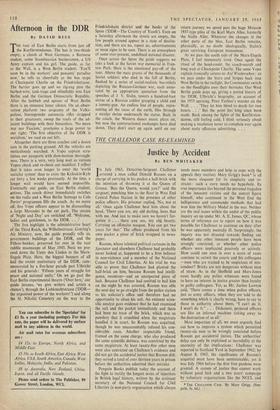Afternoon in the DDR
By DAVID REES
TILE tour of East Berlin starts from just off the Kurftirstendamm. The bus is two-thirds empty, a clutch of West Germans, a Burmese student, some Scandinavian businessmen, a US Army captain and his girl. The guide, as far as the Wall, is a West Berlin student. 'You'll soon be in the workers' and peasants' paradise now,' he tells us cheerfully as the bus stops at Checkpoint Charlie on the Friedrichstrasse. The barrier goes up and we zig-zag past the barbed-wire, tank-traps and Minefields into East Berlin and the German Democratic Republic. After the hubbub and uproar of West Berlin there is an immense lunar silence. On an obser- vation platform two sergeants of the Volks- polizei, Sturmgewehr automatic rifles strapped to their greatcoats, sweep the roofs of the ad- jacent buildings with their binoculars. 'No more war nor Fascism,' proclaims a large poster to our right; `The first objective of the DDR is socialism,' we read on our left.
Altogether there are three coaches and a dozen cars in the parking ground. All the vehicles are meticulously searched. A Vopo captain scru- tinises our passports with slow-motion thorough- ness. There is a very, very long wait as various Vopos check and re-check our manifest. I reflect that it takes even longer to enter the 'world socialist system' than to cross the Kyleakin-Kyle car ferry a few weeks previously. At the time, a longer wait would have seemed impossible. Eventually our guide, an East Berlin student, arrives. The coach driver immediately switches on the radio and a West Berlin 'homage to Cole Porter' programme fills the coach. As we move off, five Vopo officers appear to be dismantling a large Mercedes in the car park. The strains of `Night and Day' are switched off. 'Welcome, ladies and gentlemen, to the DDR. . .
The first highlight is the administrative heart of the Third Reich, the Wilhelmstrasse, Goering's Air Ministry, now, the guide proudly tells us, government buildings of the DDR, and the Ftihrer-bunker, preserved for ever in the vast rubble moonscape of May .1945. Next we pro- ceed down the Unter den Linden to the Marx- Engels Platz. Here, the biggest banners of all hail the recent anniversary of the DDR, com- memorated by a five-hour parade past Ulbricht and his generals: `Fifteen years of struggle for peace and national unity.' On we go past the East Berlin experimental theatre Myer here,' our guide intones, 'we give writers and artists a chance'), through the Liebknechtstrasse ('DDR- the organised power of the workers! ') and along the St. Nikolai Cemetery on the way to the Friedrichshain district and the banks of the Spree ('DDR—The Country of Youth'). Even on a Saturday afternoon the streets are empty, the few people around appear in a state of destitu- tion, and there are no, repeat no, advertisements or neon signs to be seen. There is an atmosphere of some ever-present, undefined national disaster.
Once across the Spree the guide suggests we take a look at the Soviet war memorial in Trep- tow Park. Here is the emotional pay-off of the tour. Above the mass graves of the thousands of Soviet soldiers who died in the fall of Berlin, flanked by a series of social-realistic bas-reliefs depicting the Russian-German war, each anno- tated by an appropriate quotation from the speeches of J. V. Stalin, towers a hundred-foot statue of a Russian soldier grasping a child and a tommy-gun. An endless line of people, repre- senting all the races of the earth, files through a secular shrine underneath the statue. Back in the coach, the Western dance music plays on, but now the conversational exchanges have died down. They don't start up again until on our
return journey we speed past the huge Moscow 1937-type piles of the Karl Marx Allee, formerly the Stalin Allee. Whatever the changes in the other parts of the bloc, East Berlin remains, physically, as no doubt ideologically, Stalin's great surviving European monument.
As we pass the south side of the Marx-Engels Platz, I feel immensely tired. Once again the ritual of the head-count, the coach-search and long wait at Checkpoint Charlie. The same Vopo captain ironically salutes us Au/ Wiedersehen: as we pass under the Stars and Stripes back into West Berlin in the twilight, the Communists switch on the floodlights over their barracks. Our West Berlin guide pops up, giving a potted history of the DDR, Ulbricht's biography, an account of the 1953 uprising, Peter Fechter's murder on the Wall. . . . 'They let him bleed to death for two hours. . . .' But the point has long since been made. Back among the lights of the Kurffirsten- damm, still feeling cold, I think seriously about making a resolution never to complain ever again about nasty offensive advertising. . . .


































 Previous page
Previous page